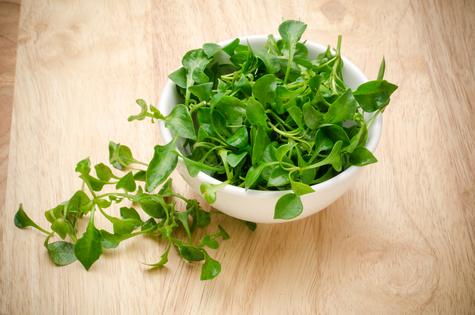Environmental Nutrition: Wondrous watercress
Tiny and delicate, watercress is the picture of serenity along softly moving springs and creeks.
The folklore
Don’t be fooled — this leafy green is surprisingly bold with its peppery taste and crisp bite. Watercress is known around the world with a history that began more than 2,000 years ago. Enjoyed by ancient Persians, Greeks and Romans, it’s even thought to have been on the menu of the first Thanksgiving. It was also widely used for its health benefits, such as to treat blood disorders and prevent scurvy in sailors. Packed with enough nutrients to rival its lively flavor, watercress makes an excel- lent addition to your cooking lineup.
The facts
Watercress (Nasturtium officinale) belongs to the mustard family, along with kale, broccoli, Brussels sprouts and radishes. A semi-aquatic plant, watercress grows naturally in and around water, like shallow streams and springs, and in wet or damp soil. It can also be grown hydroponically, a method of growing plants without soil. The entire plant is edible, though the small, round, dark green leaves and light green hollow stems are most commonly eaten. A two-cup serving of this leafy green packs nearly one and a half the DV (Daily Value, based on 2,000 calo- ries/day) of vitamin K, 32% DV of vitamin C, and 12% DV of vitamin A.
The findings
Rich in several plant compounds, including glucosinolates, polyphenols and carotenoids, watercress has been studied for its antioxidant, antibacterial, anti-inflammatory, anticancer and heart-protective properties and its potential for positive therapeutic treatment of human disease (Evidence-Based Complementary and Alternative Medicine, 2021). According to a study in the journal Food (2021), eating watercress during the recovery phase after exercise led to an anti-inflammatory response to exercise-induced inflammation, which may be due to the presence of glucosinolates, known to have beneficial effects in exercise performance and recovery, in watercress.
The finer points
Watercress is generally available year-round. Its leaves and stems are peppery, pungent and slightly bitter, similar to arugula or mustard greens. Enjoy watercress as a salad base or to add a zip of flavor to other salad greens. Kick up the flavor of sandwiches, such as egg salad or avocado toast, or top a pizza hot from the oven with this fresh, crisp green. Cooked watercress, which is tamer in taste, is well-suited to soups, sautees, stir-fries, whole grain pilafs, and egg dishes like omelets, frittatas and quiche.
(Environmental Nutrition is the award-winning independent newsletter written by nutrition experts dedicated to providing readers up-to-date, accurate information about health and nutrition in clear, concise English. For more information, visit www.environmentalnutrition.com.)
©2025 Belvoir Media Group, LLC. Distributed by Tribune Content Agency, LLC.











Comments